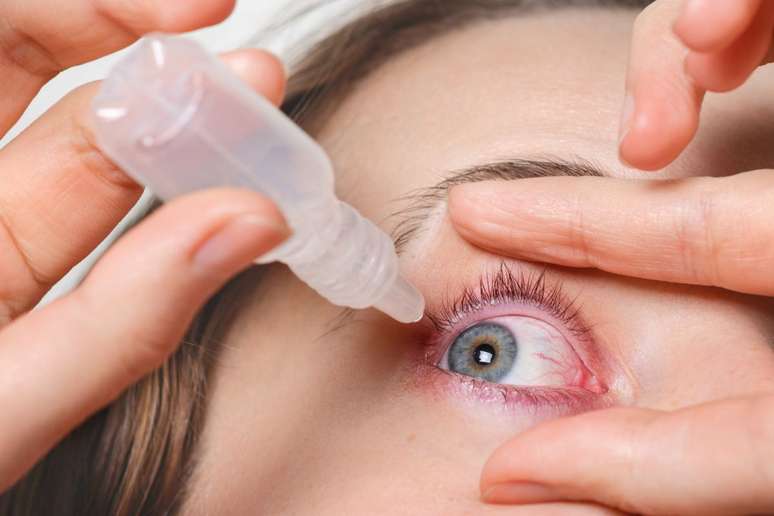Learn more about the different types of conjunctivitis and what to do to stay away from this problem
A conjunctivitis It is an eye condition that becomes even more common during the colder seasons. This is because, at these times of the year, people tend to stay indoors and have more contact with allergens, such as dust mites, accumulated in clothes and blankets stored in the wardrobe.
“When it is cold, we have the habit of staying in places without ventilation, which facilitates the spread of viruses between people and the accumulation of dust and mites, increasing the possibility of eye problems,” explains the Doctor Samantha de Albuquerqueophthalmologist and consultant at HOYA Vision Care.
So, check it out what is conjunctivitisthe symptoms of this disease, how to avoid it and more information!
What is conjunctivitis?
Second Doctor Daniele Kamlotophthalmologist, conjunctivitis is the inflammation of the conjunctivawhich performs functions such as protection against foreign bodies and microorganisms and maintenance of ocular lubrication.
“The conjunctiva is a thin, clear membrane that covers the sclera (the ‘white of the eye’),” explains Dr. Samantha.
What are the causes of conjunctivitis?
Conjunctivitis can be caused by allergic reactions (when irritants such as pollution, mites, dust, makeup and pollen get into the eyes), virus, bacteria and even fungus.
“Viral and bacterial conjunctivitis are infectious and can be transmitted. In both cases, there is a red eye and a speckled sensation in the eye. In viral cases, this often happens tearingwhile in bacterial ones there is a more abundant secretion” Albuquerque says.
Allergic conjunctivitis is not spread from person to person, according to Dr. Mylene Matsuharaophthalmologist at the Instituto de Olhos Minas Gerais and member of the Brazilian Low Vision Society.
“Allergic conjunctivitis can often be associated with rhinitis,” adds Dr. Daniel.
Transmission of conjunctivitis
The doctor says that conjunctivitis, especially viral conjunctivitis, is transmitted direct contact with the eye secretions of an infected person OR with contaminated surfaces and objects.
“If, for example, you touched a contaminated door handle and scratched your eye, you could contract the problem,” Kamlot reveals.
Symptoms of conjunctivitis
The main symptoms of conjunctivitis I am:
- Redness of the eyes;
- Burning and sandy sensation in the eyes;
- Tore up;
- Sensitivity to light;
- Blurred vision;
- Swollen eyelids;
- Itching;
- Secretion.
“In bacterial cases, the secretion is greater. In viral cases, irritation and the sensation of sand in the eyes are the symptoms that tend to bother the patient the most. In allergic conjunctivitis, itching and swelling of the eyelids are more common.”, specifies the Dr. Daniel.
How to treat conjunctivitis?
“OR diagnosis occurs through a detailed clinical evaluation, including the patient’s medical history and a physical examination of the eyes. In some situations it may be advisable to collect a sample of ocular secretion for laboratory analysis”, underlines the Dr. Tiago César Pereira Ferreiraophthalmologist specializing in refractive surgery, cataracts, contact lenses and keratoconus.
OR treatment It is determined based on the cause of conjunctivitis, i.e. whether it is bacterial, viral, allergic or fungal.
“In allergic conjunctivitis, in addition to cold compresses AND lubricant, anti-allergic eye drops are indicated. In bacterial cases they can be prescribed eye drops with antibiotic medicines. In viral cases, eye drops are enough to relieve the symptoms”, summarizes Dr. Samantha.
The time it takes for conjunctivitis to improve also varies. “Viral cases can last 5 to 7 days, bacterial cases can last a little longer allergies tend to resolve more quickly“, says HOYA Vision Care consultant.
“In case of allergic conjunctivitis it may not be necessary withdrawal from daily activities. However, for viral and bacterial conjunctivitis, this treatment is important to avoid contagion”, warns the ophthalmologist.
Prevention of conjunctivitis
For prevent conjunctivitisFerreira says it’s essential:
- Maintain good eye hygiene;
- Wash your hands regularly;
- Don’t touch your eyes with dirty hands;
- Don’t share personal items, such as towels and cosmetics;
- Keep contact lenses clean and disinfected;
- Leave the rooms well ventilated;
- Avoid contact with infected subjects;
- Wear protective glasses in places with high exposure to allergens or irritants.
Source: Terra
Ben Stock is a lifestyle journalist and author at Gossipify. He writes about topics such as health, wellness, travel, food and home decor. He provides practical advice and inspiration to improve well-being, keeps readers up to date with latest lifestyle news and trends, known for his engaging writing style, in-depth analysis and unique perspectives.









